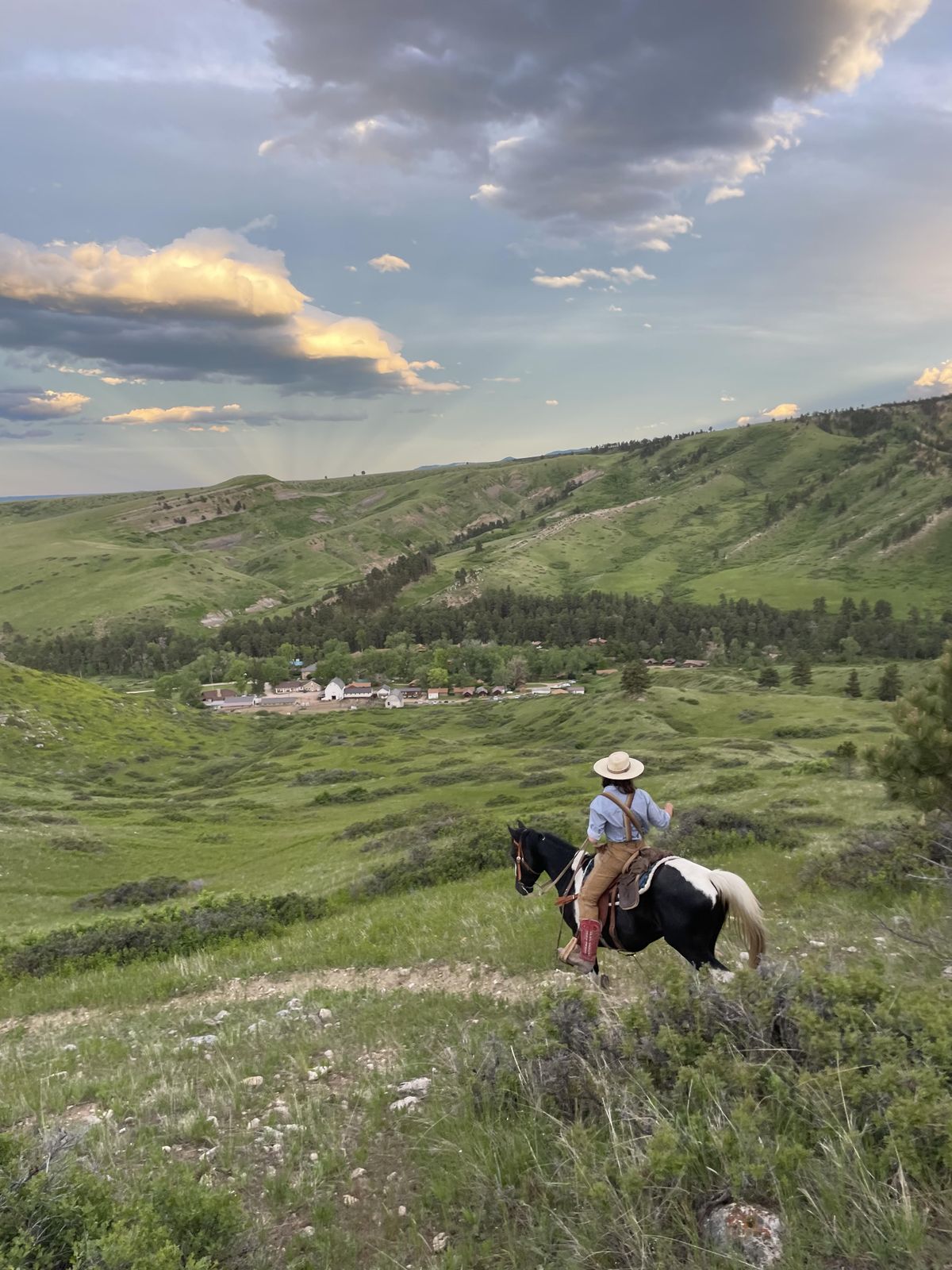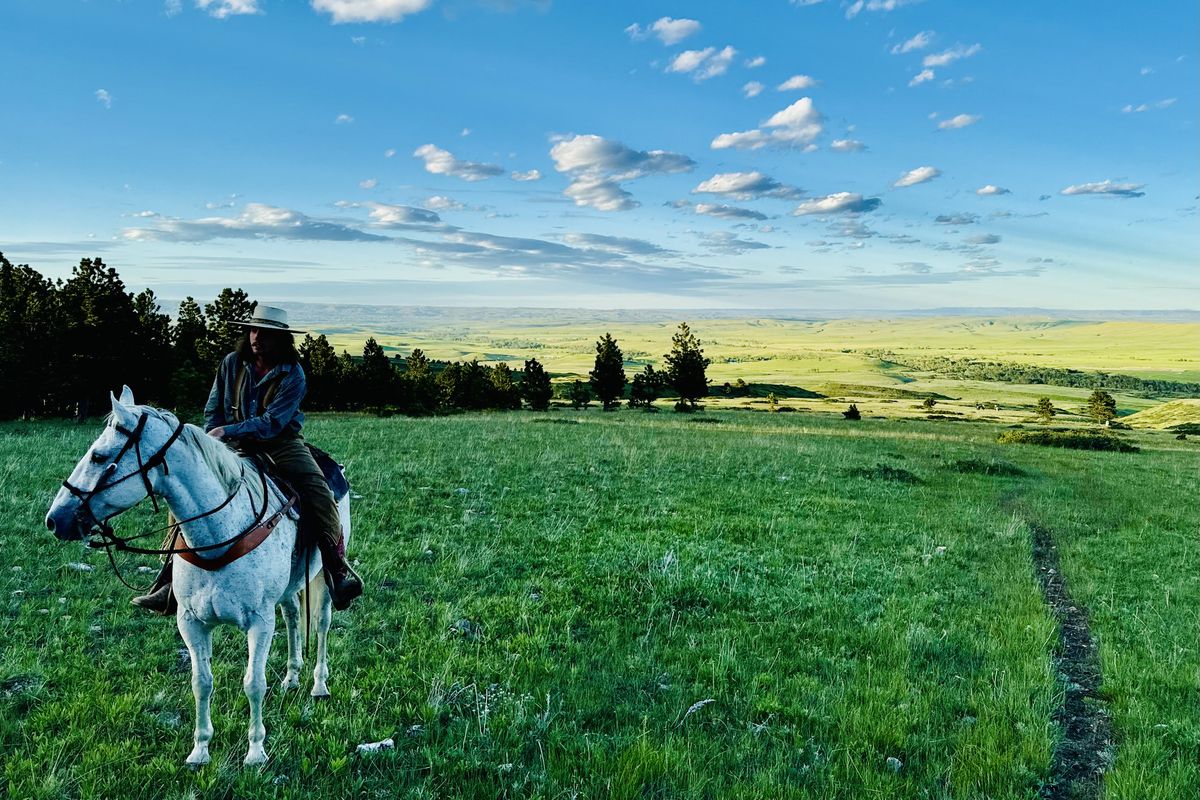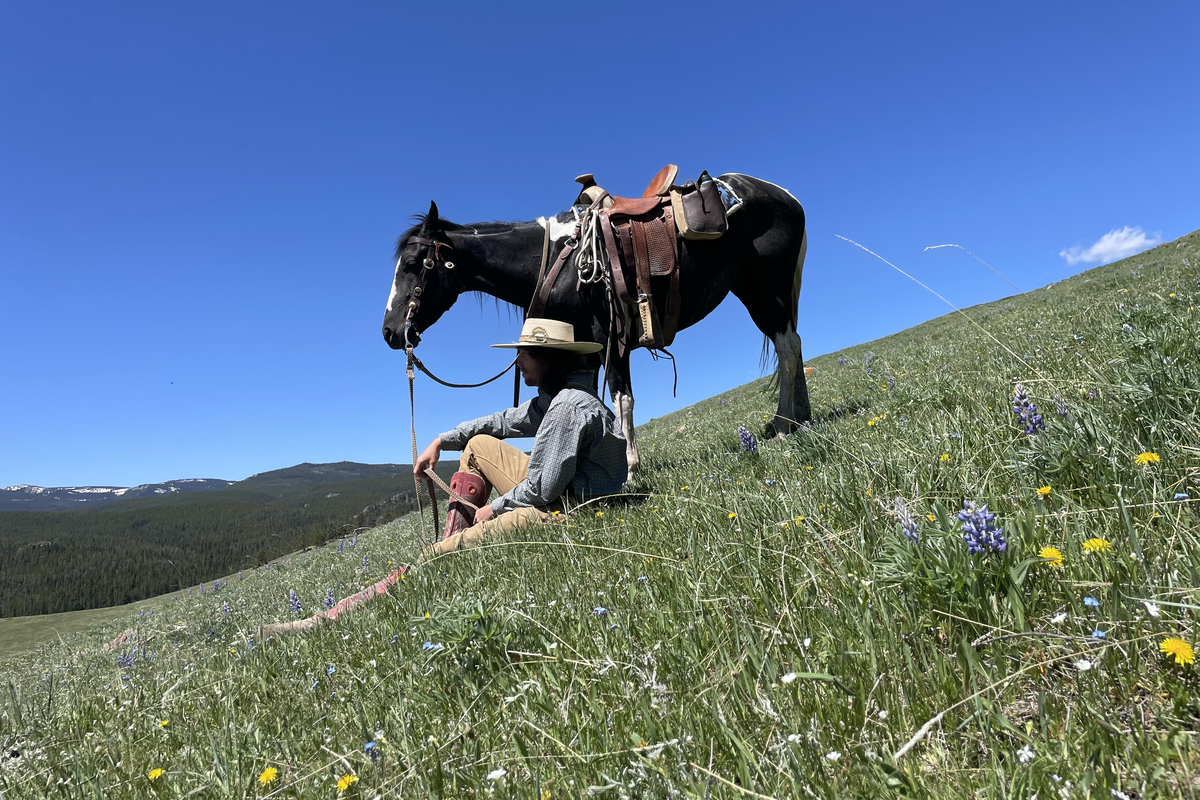A modern-day old-fashioned cowboy: Grandfather, with granddaughters in tow, meets Midwest-mannered Oliver Rodgers on Wyoming ranch
Cowboy Oliver Rodgers sits with his horse Domino on a Wyoming hill. (Mike Nolan/For The Spokesman-Review)
“As long as there are cows and horses around, you’ll need someone like me,” our wrangler said when I asked if someone could earn a living cowboying these days.
My granddaughters and I were horseback riding in Wyoming, on a ranch with 7,000 acres of scenic countryside at our disposal and a wrangler to show us the way. The girls and I loved it. Over the course of a week, our lanky wrangler, Oliver Rodgers, displayed an easygoing, soft-spoken manner that inspired confidence: We knew we were in good hands.
Rodgers guided us and looked after our horses – coaxing them, patting them, talking to them. It was clear he possessed a thorough understanding and appreciation of these animals. He also projected a wonderful mixture of Midwest manners (everything was, “Yes sir, yes ma’am”) and engaging straight talk.
“There was no question as to what I’d grow up to be,” Rodgers told me, “because I was born and bred on my dad’s cattle ranch in Corpus Christi, Texas, where we raised and trained horses. I was around horses and cattle and wranglers all the time. My earliest memories were of my dad bronc riding in rodeos, and my friends were all kids of my dad’s rodeo buddies.”
“So someone can actually make a living as a cowboy?” I asked. “There’s a future in it?”
“Yes, sir,” Rodgers said with his casual but competent demeanor. “After high school I had a number of jobs: working in a restaurant … doing retail … working as a welder in a factory. But those jobs were mind-numbing. They didn’t let me move around. I needed motion and I needed something to keep my mind active. With horses, I’m always watching, thinking and reacting.”
Rodgers took a step back, thought for a second, then said, “Wherever I’ve worked as a wrangler, the days always start early, so it’s a good thing I like sunrises. There are late nights, too. I guess it’s just long hours overall … but if you enjoy what you’re doing, it’s not really work, is it?
“I’ve been herding cattle, doctoring cows, guiding trail rides, training and breaking horses all my life. As long as there are cows and horses around, you’ll need someone like me to wrangle them.”
Rodgers left home at 17 to work in Colorado as a hunting guide. The hunters were on horseback, up to 15 people in a pack, and Rodgers lead them hunting elk.
The following winter, he broke and trained horses in South Texas, then guided trail rides in the beautiful, rugged expanses of Yellowstone National Park.
“One of the jobs was to go out on the trail ahead of time and make sure the path was clear of buffalo and elk and grizzly bears. It’s called ‘hazing’ and, for grizzlies at least, involves using bear spray.
“My horse was well-trained and knew his job. When he’d hear my rope swing above his head, he knew to run toward the bear, then stand sideways so he wouldn’t get sprayed. Of course, it’s not as simple as it sounds. You, the horse, and the bear usually end up getting sprayed.
“It’s bad, because the stuff sticks all over you, and when you sweat it runs down under your clothes. You can’t touch your eyes or lips or, god forbid, a cut.”
Rodgers then trained horses at a ranch in an incredibly scenic part of Northern Montana, by Glacier National Park.
“It was fun, just working all day with horses. Probably some of the best work I ever had.” Rodgers looked at me, his eyes serious. “Horses don’t talk back,” he said with his deadpan humor, then smiled and added, “sometimes you need to vent, and the horse will just listen.”
In between guiding us and helping my granddaughters and me with our horses, Rodgers told us other stories about cowboying.
“One time I worked on a ranch that had this little mule that nobody could ride. As it turns out, most of the wranglers at this particular ranch were smaller guys – short and not weighing much. A mule is beyond smart, and by now this mule had realized he could get anyone off him easily.
“I walked out to the corral one morning and they had blindfolded this mule in an attempt to get him to cooperate. I watched probably five wranglers get thrown. I walked over and sat down on this mule, and with me being more than 200 pounds and over 6 feet tall, the mule lets out a good amount of air when I settled down on the saddle. I knew I was in for a good ride.
“I slipped that blindfold off his eyes, and before I could say a word, we were both looking at blue sky and white clouds. He came off the ground, straight up, trying to roll his belly overhead and fall on me, but I was ready. When we hit the ground, I was on my feet in the stirrups above him, waiting for his next buck. This went on for probably 15 minutes, twisting and bucking and jumping around this huge corral, running into horses, jumping in the hay bunk, falling and squealing and biting and kicking. Fifteen minutes might sound like a short amount of time, but by then we were ’bout plumb soaked through with sweat. Finally, he stands up again, and this time when I ask him to go forward, he does. We had reached an agreement. The door was finally open, and we could start to work on the things we needed to work on.
“It’s funny … once that mule got over acting like a fool, he got to the point where he’d be protective over me in the corral, and even get mad if I saddled another horse next to him.” Rodgers beamed with a clear sense of satisfaction.
“From that point on, there was no fussing, no fighting, no problems. I made that mule into one of the ranch’s most stable animals.”
The next spread Rodgers worked on was in Big Sky, Montana. “I learned how to drive a horse and buggy carriage. The rig had two big draft horses, and I could haul fifteen to twenty people at a time. It was fun, and people loved taking a step back into history with me.”
Sometimes Rodgers worked with other wranglers, sometimes alone.
“I’ve worked on cattle ranches moving 400 or 500 cows to graze and water in different mountain pastures,” he said. “I’d ride out with a pony behind me as a packhorse, with food and water. You bring a tent, a bedroll and a sleeping bag, and stay out for two or three weeks at a time. It goes on all year. The most I ever did was 1,600 cows – me and two other guys.”
At a dude ranch in Wapiti, Wyoming, Rodgers lead trail rides and trout fishing trips.
“That’s where I bought my first – my own – horse,” he said. “I worked for the season, then trailered my horse to Dunmore, Montana, working on the Crow Indian Reservation.
“I was on a small family ranch, owned by tribal members, training horses for rodeo – calf roping, barrel racing, things like that. I worked there over a year and, living on the ranch, it really didn’t feel like work. It was almost like being a kid again, where you get to just enjoy herding cattle and working with horses.”
Rodgers’ passion for the work was evident.
“I remember buying my first ‘project’ horse, a huge half-draft named Spades. Horse was scared of his own shadow,” he said. “After weeks of trying to break him of spooking, I went up the mountain to go check on a trail ride that had headed out. I was wanting to get back ’cause a huge storm was rolling in.
“Well, on that check-up, my wallet came out of my back pocket, it turns out about 7 miles up this mountain trail. I get back to camp without even noticing and, of course, the storm rolls in. Thunder and lightning all over the mountain.
“I had to find my wallet, so I saddle Spades back up and tell the other wranglers, ‘If I’m not back in two hours, come lookin’.’
“So Spades and I take off back up the trail, and I’m pushing this horse faster than I ever pushed him before, and about three minutes in, we’re linked up. He knows every little thing I’m asking him to do, and he’s doing it with all his heart, from jumping creeks and logs, to trampling through juniper bushes and disregarding rocks. We continue riding through thunder and lightning so thick it’s making my hair stand on end.
“At a dead gallop I happen to look down in a juniper bush and my face is looking back up at me – small and in full color – my wallet was open to my driver’s license.
“I hop off of Spades, grab my wallet, and come flying down that canyon to camp. The other wranglers said they could hear me hollerin’ from a mile away.” Spades was cured of his skittishness.
Rodgers paused over the memory with a satisfied look on his face, then shrugged his shoulders and said, “It’s all part of cowboying: changing jobs here and there, seeing different scenery. Wherever there are horses, there’ll be a job. It’s rewarding work, and at the end of the day, you feel like you actually did something. You can make a pretty good living, too. It’s allowed me to buy property in Montana – 200 acres – and build a house.”
Rodgers was silent a moment, his haze-gray eyes containing a vast, silent prairie. Then he said, “There’s a romanticized view of cowboy life I suppose, but there’s an identity that goes with it, too. It feels good. When I tell myself I’m a cowboy … yeah … that identity feels good.”
Mike Nolan writes travel stories and personal profiles for The Spokesman-Review, the Seattle Times and AAA Journey magazine.


